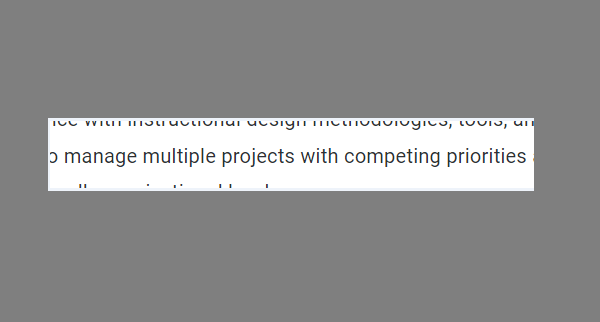My Medium Content
Thanks for stopping by! The content here is going to be in a little flux for a while because I’m moving items and shifting some of my media creation over to Medium as a way to leverage the power of the publishing platform. I’ll still post a unique blog here and on LinkedIn from time to time, but my main focus will be on that site.
Get in touch!
pmann@educationalthinking.com
(717) 400-6266 (voicemail)
Harrisburg, PA

CP2077: THE COST OF POORLY MANAGING EXPECTATIONS
Cyberpunk 2077 (CP2077) by CD Projekt Red Studio in Poland (CDPR, Stock: OTGLF) may be the most successful project failure in software development in history. On the one hand, it is unambiguously successful. The record sales figures for the first ten days following the December 10, 2020 release exceed 13 million copies (≈$780M) even after the raft of highly publicized, no-questions-asked refunds due to bugs and playability issues. On the other hand, the project is a failure for investors because its record sales fell short of analyst expectations of 16.4 million copies (≈$984M). For consumers, it failed because of eight months of delays followed by a delivery that lacked anticipated features. It did not perform as expected – being virtually unplayable on some legacy consoles – resulting in responses such as Sony removing the title from its PlayStation online store for all of its platforms.

MANAGING PROJECTS AND MANAGING CHANGE: THE SOLUTION TO PM VS. OCM
Putting arguments, assertions, and turf defense to the side, PM and OCM are only distinct when neither considers the whole purpose and process of the change. To truly succeed, every project must include the technical and functional requirements, and facilitate the accomplishment of both. When done properly, correctly verified technical requirements and correctly validated functional requirements results in a successful and successfully adopted project.

PROJECT ESTIMATES AND UNDERSTANDING SUCCESS
Organizations that want meaningful long term project success need to reinforce the basics of estimates. We need to finish the conceptual equation by connecting the methods of calculating our expected costs to the way we use those figures to baseline projects and define success or failure. Finally, we need to eliminate the inconsistent views of estimates that create varied perceptions of “success” and “failure” so that everyone involved has the same understanding of what it means to be “on target.”

Do Your Priorities Compete?
Priorities that appear to conflict do not need to be managed, they need to be prioritized. In an earlier article, I wrote about ways to deconflict priorities, and that recommendation stands. When organizational priorities appear to be at odds, it means most simply that it is not clear which priority is more important than any other. This is a clarity problem, not a conflict.
How Are Your Blinkers?
Blinkers filter-out the confounding traits of many other modes of communication (e.g. language, posture, tone, environment, etc.), thus rendering inert most of the external forces we can blame for communication problems except the natural complacency that comes with years of driving (and communicating), the blinker exposes our native habits of communicating in ways that might surprise us.

Are You Compartmentalizing Your Culture?
Organizational culture is often an aspirational quality that leaders plan to work on when they have time, attention, resources, or whatever. Culture becomes, at some point, a repository of the hopes and dreams of a high-functioning and internally consistent workforce that lives in its own little compartment of reality, separated from the operational and personnel practices that could make it a reality.

Make Help More -- Helpful!
If someone cares enough to notice that you need help, whether via a consultant or not, it is a better option to consider that, 1) someone cares enough to notice the need, and 2) there is an opportunity to find and fix a blind spot in your perspective. Someone like me isn’t there to force a change or otherwise stick our noses into your business; we’re there because someone feels things need to adjust but aren’t going to get better on their own.

Playing Succession Too Close
One of the overriding themes of the last few years has been how to build one's bench -- how to identify and select high-potential employees (HiPos) and would-be employees to proactively enhance the team. Within this idea includes both building skills and knowledge capabilities, as well as grooming HiPos for eventual advancement into leadership as part of a long term succession pipeline. While this article relates to all of these factors, it's main focus is on the succession component and the problems that occur when we forget to tell our HiPos that they are HiPos, and what that means.

Fair Enough?
Many organizations, especially in government or government contracting, create “fair” interview panels from a deliberately (read: legally defensible) diverse group of disinterested interviewers. These interviews follow a rigidly structured protocol – though they often use behavioral interview questions, a subject of a future post – which disallows all but the most superficial pleasantries.

Three Rules for Managing Conflicting Priorities
However, the more I thought about it and the more I considered cleaver analogies, the more I became aware that the trope – and it is surely so overused as to be a trope by now – about working in a position with multiple conflicting priorities is really an indicator deep, underlying problems in an organization’s alignment with its objectives.

How S.M.A.R.T. Are You?
Organizations strive to have something reportable – usually something “green” that looks both important and constantly successful – without any chance of failure or actually changing (i.e. improving).

Your Thinking on Millennials is Wrong
There. I said it. You are wrong. Wrong about millennials, wrong about their place in the workforce, and wrong about how you are trying to gain their attention (long enough) to work for you. Just. Plain. Wrong. On at least three counts.

Stop Right There!
There is another horrible notion going around that you can attract, hire, and retain the best people if you can just figure out how to comply with all of the applicable laws and diversity initiatives dreamed up over the last couple of years. If you get the ratio du jour of colors, shapes, and plumbing, then you will have an environment of egalitarian inventiveness and creativity like nothing seen short of Star Trek.

You Get What You SEO For
…most of us would love to work in a place where our position was less cookie-cutter and more deliberately aligned with both our talents and the cultural identity of the company we work for. Likewise, I’m not bothered about the government-like titles such as “Aviation Technical Systems Specialist,” because it is a given that those don’t mean anything at all unless one searches the specific requirements of the position.

Recent Graduates …Only?
It is both amusing and problematic that the old paradox of recent graduates with 10+ years of experience is going away. It is amusing because the swell in nontraditional graduates, especially in terms of those who are either finishing their education while working a career, means that it is actually possible to hire someone who graduated in the last year (i.e. recent graduate) with a decade or more of experience.

Planning to Action in 5 Easy Steps
Why then, do leaders vault over analysis and duck planning, and jump right into implementation when things really have to go right? The only thing I can think of is that there is a belief that analysis and planning have to be overly complex to work, but that's just not true.

Recruiters: Do You Want Qualified Veterans or Just Veterans?
Whether or not someone is a veteran should only give you a point of reference to find out more, but should never really be viewed as the total a person does or can bring to the table -- think about it as a piece of the puzzle, maybe even a corner piece, but it isn't the whole picture.

Do We Need (More) Rules to "Unplug?"
"Do those choices make sense in the context of the legal and ethical structure of their work agreement?" Turns out, checking email "off the clock" is dead at the first hurdle -- it isn't legal whether exempt or not.

Hiring: Does Short Term Thinking Cause Long Term Problems?
“Consider how similar hiring decisions are to romantic decisions. We interview a person based on an online profile or short resume, the candidate gets a short look at the company through a web page and an interview, and at that point both decide whether to start a relationship with them that requires us to make an investment.”

Work-Life Balance: Are Benefits On-Point?
“…benefits are one of many tools used to capture and retain scarce talent. In this context, it appears obvious that leaders would work hard to validate both the value and utility of benefits from a variety of perspectives represented in the workforce, but this isn’t the case.”
